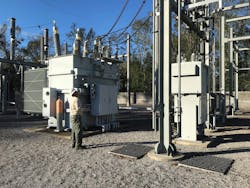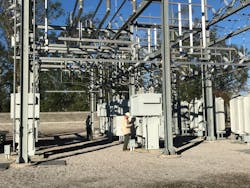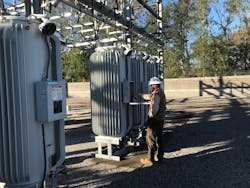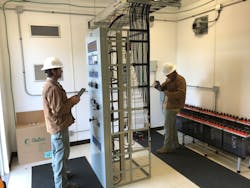Sugar-white sands and blue, balmy waters sit in stark contrast to destructive hurricanes and disastrous storms. Yet, both describe the conditions in which Riviera Utilities (RU) operates. With a geographical territory spanning the southern portions of Alabama in lower Baldwin County, RU has become adept at navigating major weather events while also supporting rapidly expanding meter growth.
More than five years ago, RU began seeking solutions to improve the consistency and efficiency in which it executed its substation inspection process. Although its manual approach to inspections was not necessarily broken, it held some inherent inefficiencies created by the physical distance between the utility’s headquarters and substations sites; a labor-intensive, paper-driven system; and normal human error. These contributing factors led RU’s leadership to search for electronic solutions. The resulting transition from reactive and manual processes to proactive and preventive ones has enabled the utility to increase its reliability and improve operational efficiency.
The Need for Change
The RU electric department serves Daphne, Spanish Fort, Point Clear, Loxley, Silverhill, Summerdale, Foley, Elberta, Lillian, Bon Secour, Magnolia Springs and West Perdido Beach, accounting for approximately 52,000 customers. The electrical infrastructure includes 90 miles (145 km) of transmission lines, 835 miles (1344 km) of overhead distribution lines, 320 miles (515 km) of underground distribution service and 20 substations.
Located in one of the fastest-growing counties in the state of Alabama, RU has experienced a dramatic uptick in running temporary services, averaging 25 to 30 new service locations per week in 2019 and 2020. Additionally, to meet the changing needs of residential and commercial customers, RU expanded its service offerings several years ago to include gas, water, wastewater, cable, internet, appliance and air-conditioning service.
As RU’s system grew, the inefficiencies of a manual, paper-intensive substation inspection process highlighted the need for change. Employing seven full-time substation technicians, RU employees monitor 425 pieces of equipment monthly. This includes regulators, breakers, transformers, current transformers (CTs), potential transformers (PTs), batteries, circuit switchers, switches and relays at eight delivery stations — six at 115 kV and two at 230 kV — and 17 distribution stations — 16 at 115/13.2 kV and one at 230/132 kV.
These skilled technicians perform everything from complete substation builds to supervisory control and data acquisition (SCADA) installations. Whether it is fiber splicing and control wiring or protection panel installations and transformer and breaker maintenance, RU relies on its in-house technical expertise to ensure substations run at optimal performance, meaning all equipment is operating daily as needed and expected.
Prior to implementing an electronic solution to asset management and inspections, RU used a manual process that involved recording inspection results in paper logs. While technically it yielded the necessary results, the paper-driven system led to inconsistencies when something was mistakenly overlooked during the inspection process. In reviewing the workflow, RU leadership found employees did not consistently target the same items and were spending additional time driving back and forth to substations simply to verify details, such as nameplate information, equipment malfunctions, service records and other overlooked inspection details.
Key Objectives
In seeking solutions for consistency and specificity, the elimination of paper inspection logs drove RU’s research to find an electronic platform that would guide users through a standardized inspection process and guarantee nothing was overlooked. To fully improve its substation inspection and maintenance process, RU wanted the ability to do the following:
- Generate work orders from the field
- Build equipment history logs to support proactive maintenance and oversight
- Streamline and standardize its substation inspection process.
With those objectives in mind, the search for a tool began. In 2014, while attending the American Public Power Association’s engineering and operations conference, leaders from RU discovered a viable solution in MinMax Technologies’ Electric System Maintenance Asset Reliability Tracking (eSMART) software. RU selected the software — a browser-based asset management, inspection and meter exchange tool —because it is specifically designed for substation asset management and met the needs of the utility.
Employee Involvement
As with any major transition, planning and preparation help to guarantee success. RU leadership collaborated closely with the eSMART supplier to develop a robust implementation plan. Having identified the eSMART platform as a viable solution, RU invited the MinMax team to present a software demonstration to a group of potential end users. RU’s leadership set the course for change, but they brought key employees into the decision-making and implementation process. Offering this early opportunity for input led to pre-implementation fine-tuning, troubleshooting and training that matched the needs and desires of RU’s engineering and technology teams.
RU first coordinated efforts internally to gather the necessary information — including types of equipment, serial numbers, sizes of transformers, regulators and switches — from each of the utility’s substations and then shared that data with the MinMax team for system input and customization. After ensuring the question prompts and functionalities were aligned with the utility’s data needs, RU prepared its inspectors to begin using the software on iPads.
While end users were somewhat hesitant about the new application initially, it only took a short amount of time and use for their opinions to change. At the start, becoming familiar with the functionality presented the biggest hurdle. Some employees feared a misstep on their part — even something as simple as clicking the wrong button — might damage the software or create significant problems. However, as employees became increasingly familiar with the tool, their uncertainties disappeared. RU management also applied functional limits based on user roles (for example, inspector vs. manager) in the organization, which added to employees’ comfort and ease of use.
A Two-Month Implementation
RU selected the eSMART 9.2 technology solution for its monthly substation inspection processes, equipment tracking and work order generation. Monthly inspections involve all equipment within an electrical substation, including direct-current (dc) batteries, battery charger, switch house, protection relays, circuit switchers, breakers, switches, disconnects, CTs, PTs, insulators, bus work, arresters, transformers, regulators, grounding and the yard.
RU inspects and tracks equipment for different purposes. For example, the utility monitors nitrogen usage on transformers to detect leaks, evaluates breaker operations to detect possible right-of-way issues, watches water usage in batteries for the dc supply, and determines gas leaks of SF6 by the usage and gauge reading. Shifting to an electronic solution enabled RU to generate maintenance work orders in the field when issues are detected.
The software’s native functionality met most of the utility’s needs. However, having the ability to customize it, where needed, enabled RU to incorporate a version of its job safety analysis (JSA) into the application. Performing a JSA ensures each job is reviewed in detail and all personnel are on the same page regarding the needs and parameters of the work to be completed. Since JSAs are performed before every job, MinMax embedded the task into the eSMART system. Creating this electronic copy eliminated the need to carry a paper document in the field.
With only minor adjustments needed to the system, the implementation process only took two months to complete. Gathering the data for migration and putting it into the supplier’s requisite Excel template took time, but once entered, the turnaround time for deployment was brief. Additionally, the supplier was easily accessible for questions and available for support from start to finish, an important factor RU believes contributed to its smooth transition experience.
Automation Benefits
Automating the substation inspection process and asset management system at RU yielded tremendous benefit. While the preparation and process for compiling and transferring data might seem daunting, the result enabled the utility to operate more efficiently and effectively. Most importantly, the initial investment in time and resources created a shift in protocols and processes that ultimately allowed the utility to enhance its mission to deliver reliable, quality and dependable services at the lowest cost possible.
In transitioning to the eSMART system, RU met all three of its desired objectives and realized significant benefits as a result. The utility’s employees quickly adapted to the software, finding it fast and easy to use. Now when populating a monthly inspection, the inspectors are guided through the process in a standardized way and can immediately generate a work order if maintenance is needed. The former process required inspectors to complete a lot of paperwork, and they had to return to the office to submit inspections for supervisor evaluation. The supervisor would generate a work order, and a crew would be assigned to complete the work order. The added steps in the paper-based process took more time to complete the inspections.
In addition, what used to take time and effort in locating and pulling paper files on past inspections, the browser-based platform now delivers within a few simple clicks. Having an easily accessible historical record gives inspectors and management, alike, important trend data needed for quality decision making.
RU embarked on this journey seeking to build efficiency and standardization into its substation inspection process. Almost seven years post-implementation, the move toward an intuitive and predictive technology tool has enabled the utility to realize gains beyond its initial expectations. Once tied to labor-intensive, inconsistent and reactive processes, RU now benefits from increased employee productivity, accurate and robust asset management, and enhanced reporting.
Chad Owen ([email protected]) began his career at Riviera Utilities in June 2003 in the meter department, where he installed, removed and read meters. As he progressed through the organization, he held various roles involving substation design, construction, testing and maintenance. Currently, he serves as substation supervisor and is responsible for all transmission line and substation designs while still overseeing and planning for the substation department.
For More Information
RU | rivierautilities.com
MinMax Technologies | www.minmaxtech.com
About the Author
Chad Owen
Chad Owen ([email protected]) began his career at Riviera Utilities in June 2003 in the meter department, where he installed, removed and read meters. As he progressed through the organization, he held various roles involving substation design, construction, testing and maintenance. Currently, he serves as substation supervisor and is responsible for all transmission line and substation designs while still overseeing and planning for the substation department.




